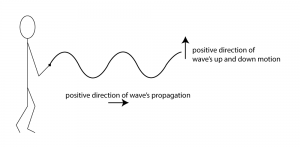[wpfilebase tag=file id=15 tpl=supplement /]
Sound waves are longitudinal waves. In a longitudinal wave, the displacement of the medium is parallel to the direction in which the wave propagates. For sound waves in air, air molecules are oscillating back and forth and propagating their energy in the same direction as their motion. You can picture a more concrete example if you remember the slinky toy of your childhood. If you and a friend lay a slinky along the floor and pull and push it back and forth, you create a longitudinal wave. The coils that make up the slinky are moving back and forth horizontally, in the same direction in which the wave propagates. The bouncing of a spring that is dangled vertically amounts to the same thing – a longitudinal wave.

[wpfilebase tag=file id=133 tpl=supplement /]
In contrast, in a transverse wave, the displacement of the medium is perpendicular to the direction in which the wave propagates. A jump rope shaken up and down is an example of a transverse wave. We call the quick shake that you give to the jump rope an impulse – like imparting a “bump” to the rope that propagates to the opposite end. The rope moves up and down, but the wave propagates from side to side, from one end of the rope to another. (You could also use your slinky to create a transverse wave, flipping it up and down rather than pushing and pulling it horizontally.)
